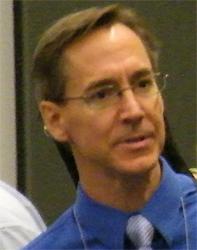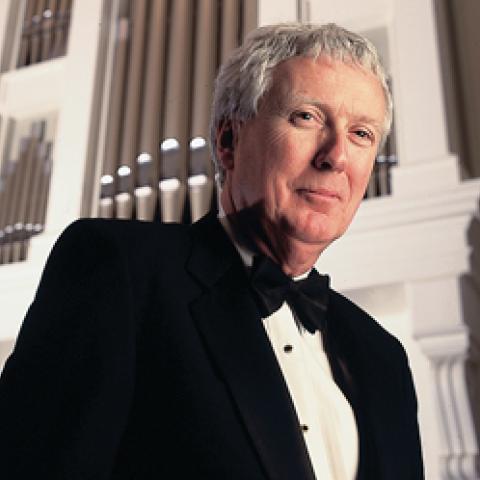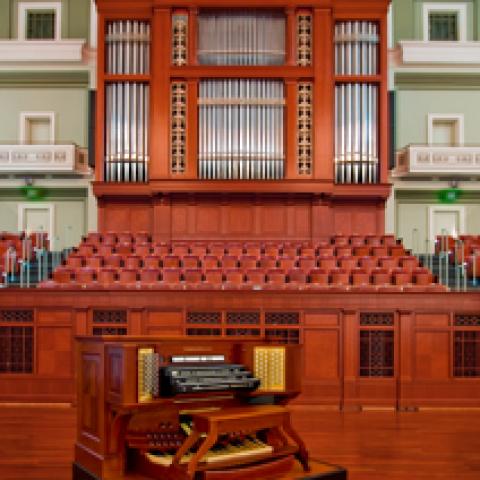Southern Methodist University’s emeritus professor of organ and sacred music Robert Theodore Anderson succumbed to Parkinson’s disease on May 29 in Honolulu, Hawaii. Born in Chicago on October 5, 1934, RTA (as he was affectionately known by hundreds of students and friends) received his early training at the American Conservatory of Music in Chicago. Undergraduate work was accomplished at Illinois Wesleyan University (Bloomington), where he studied organ with Lillian Mecherle McCord. At Union Theological Seminary in New York, he was awarded the degrees Master of Sacred Music (magna cum laude) in 1957 and Doctor of Sacred Music in 1961. He was an organ pupil of Robert Baker and studied composition with Harold Friedell and Seth Bingham.
A Fulbright Grant awarded in 1957 permitted Anderson to study in Frankfurt with Helmut Walcha. During the two years he spent in Germany, he served as guest organist at Walcha’s Dreikoenigskirche, and toured as a recitalist under the auspices of the American Embassy.
Anderson began teaching at SMU’s Meadows School of the Arts in 1960. He retired from the school (because of ill health) in 1996, but continued to teach for several more years to complete the degree programs of his final organ majors. Dr. Anderson was promoted to full professor in 1971, and was subsequently awarded the first Meadows Distinguished Teaching Professorship and named a University Distinguished Professor (SMU’s highest rank).
Two of RTA’s students, Wolfgang Rübsam and George C. Baker, won first places at the prestigious Chartres Organ Competition, and many others repeatedly placed in American contests. Anderson was known for his widely comprehensive organ repertoire and toured extensively as a solo recitalist, for a time under the auspices of the Lilian Murtagh/Karen Macfarlane Concert Management. A Fellow of the American Guild of Organists, Anderson served that organization as National Councillor for Education. He was Dean of the Dallas AGO chapter (1965–67), and served in many other capacities during his years in Dallas. The chapter named its annual recital series in his honor at the time of his retirement.
Anderson’s funeral was held at the Lutheran Church of Honolulu on June 3, with organist Katherine Crosier at the Beckerath organ and RTA’s Union Seminary classmate Nyle Hallman playing harp. His ashes will rest in Chicago, next to those of his parents. SMU is planning a Dallas memorial service, to be held in September.
—Larry Palmer
Howard Clayton died March 5 in Norman, Oklahoma. He was 79. He had earned degrees in education from Emporia State University, Emporia, Kansas, in music from the American Conservatory of Music in Chicago, and a Ph.D. in general administration from the University of Oklahoma. Dr. Clayton held music teaching positions in Illinois before switching his emphasis to library science, which he taught at the University of Oklahoma. He had also held positions at other universities, including Pittsburg State University in Pittsburg, Kansas. He was editor of the educational journal Learning Today from 1968–85. At the time of his death, he was serving as organist at St. John Nepomuk Catholic Church in Yukon, Oklahoma. Howard Clayton is survived by his wife of 59 years, Wilma, daughter Caren Halinkowski, son Curtiss, brother Paul, a granddaughter, and nieces and nephews.
Everett S. Kinsman, age 86, died January 14 in Bethesda, Maryland. He had studied at the Catholic University of America and was an organ student of Conrad Bernier and Paul Callaway. He had served at St. Matthew’s Cathedral and St. Patrick’s Catholic Church in Washington, D.C., and was organist at the Shrine of the Sacred Heart for 22 years, beginning in 1949. His last position was at Our Lady of Mercy Church in Potomac, Maryland.
Mark L. Russakoff died April 12, Easter Sunday, at the age of 58. He had served most recently as director of music ministries at St. Irenaeus Catholic Church in Park Forest, Illinois.
Born in Birmingham, Alabama, September 16, 1950, he studied piano with Samuel and Delores Howard at Birmingham-Southern Conservatory, and organ with Joseph Schreiber at Birmingham-Southern Conservatory and with H. Edward Tibbs at Samford University. He earned a bachelor of music degree at Washington University, St. Louis, studying organ with Robert Danes and Howard Kelsey, and harpsichord with Anne Gallet. He also studied organ with Pierre-Daniel Vidal and harpsichord with Agnès Candau at the Strasbourg Conservatory, and earned master’s and doctoral degrees in organ at Northwestern University as a student of Wolfgang Rübsam and Richard Enright.
Russakoff taught at Chicago Musical College of Roosevelt University and at Thornton Community College. He served as organist/director of handbell ensembles at Flossmoor Community Church, director of music at St. Emeric Catholic Church, Country Club Hills, and was music editor and engraver for ACP Publications in South Holland. He is survived by his wife Cynthia, daughter Rachael, and sister Dale.
Charles Shaffer, 78, died May 2 in Los Angeles. Born in Akron, Ohio on November 17, 1930, his first piano lessons were in the Akron public schools, and he was a boy chorister at St. Paul’s Episcopal Church there. During World War II, Shaffer and his family moved to South Gate, California, where he continued his piano studies and deepened his interest in playing the organ and in organ building. By age thirteen he was playing services at St. Margaret’s Episcopal Church in South Gate. During his high school years, the family moved back to Akron, and Shaffer took his first organ lessons and attended his first meetings of the AGO chapter there.
Shaffer’s first year as an undergraduate was spent at Oberlin Conservatory, where he studied with Fenner Douglass. His studies were interrupted when he was drafted to serve in the U.S. Army during the Korean Conflict. Upon discharge from the service he continued his studies at the University of Redlands (California), where he studied with Dr. Leslie P. Spelman and earned bachelor’s and master’s degrees in organ performance.
Charles Shaffer served for eighteen years as organist of First Presbyterian Church in Hollywood, California, and later at First Baptist Church in Pasadena. An active teacher and performer, he served the AGO in various capacities at the local and regional level and several of his articles have appeared in The American Organist.
In the early 1990s he was invited to consult on an organ renovation project at Westwood United Methodist Church in Los Angeles. His role soon evolved from consultant to principal donor and co-designer of what has come to be called the Shaffer Memorial Organ (in memory of his wife of 29 years, Phyllis). The core of the organ was a large pipe instrument installed by Schantz in 1995. The expansion and revision of this instrument occupied Shaffer for the rest of his life. With co-designer Burton K. Tidwell and others, the organ has grown to include 153 ranks of pipes and 83 digital voices located in the chancel and gallery of the church and controlled by a four-manual and a two-manual console. It is one of the largest organ installations in southern California and was heard at the 2004 AGO convention.
Shaffer’s generosity to the church’s music ministry also included the gifts of five pianos (in memory of his parents and his wife’s parents), a digital carillon system, and seed money for an endowment fund to care for the instruments. About the many years of their close collaboration, Burton Tidwell has written of Charles, “His desire to explore possibilities beyond the ordinary, and then see that they could happen, has challenged and expanded my own concepts of organ building. Mr. Shaffer’s vision and generosity have provided all of us with a lasting legacy.” Charles Shaffer is survived by his sister, Lona Abercrombie, three nephews and three nieces.
—Gregory Norton
Minister of Music
Westwood United Methodist Church
Los Angeles, CA
Frank B. Stearns died February 4 at the age of 67 in Pittsburgh, Pennsylvania. Born in Brattleboro, Vermont, he received a bachelor of music degree from Westminster Choir College in Princeton, New Jersey, and a master’s of music from the University of Pittsburgh, as well as a master of education degree from Slippery Rock University. He served as an elementary teacher for 28 years, and was director of music for 31 years at Zion’s Reformed United Church of Christ in Greenville, Pennsylvania. For the last ten years he was director of music at Center Presbyterian Church in Slippery Rock. Stearns was active in community musical groups and was also a member of numerous musical and historic organizations, including the American Guild of Organists, the Organ Historical Society, the American Recorder Society, and the Mercer County Historical Society, which named him Volunteer of the Year in 2007. Frank Stearns is survived by his wife of forty years, Patricia, sons Jim and David, and two grandchildren.
Raymond A. Zaporski, age 81, died on February 28 in Roseville, Michigan. He was a music minister-organist for the Archdiocese of Detroit for over 50 years, serving St. Angela Parish Church in Roseville, St. Blase Catholic Community in Sterling Heights, and St. Anne Catholic Community in Warren, Michigan. Raymond Zaporski is survived by his wife, Dorothy, sons Mark, Michael, and Martin, daughter Mary Beth, and their families.







